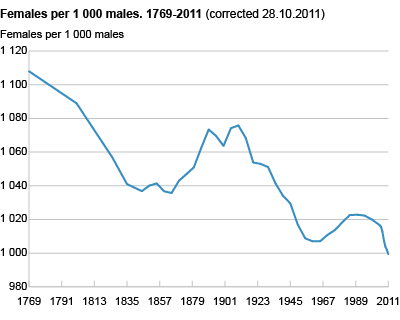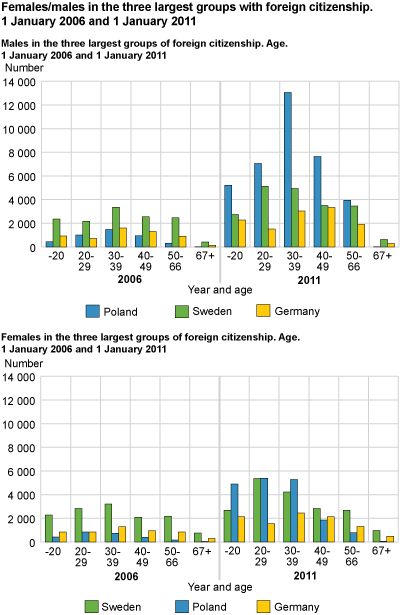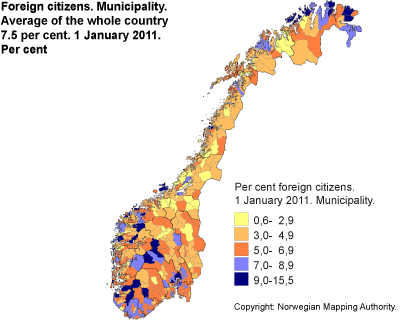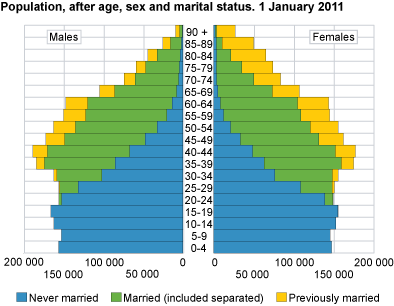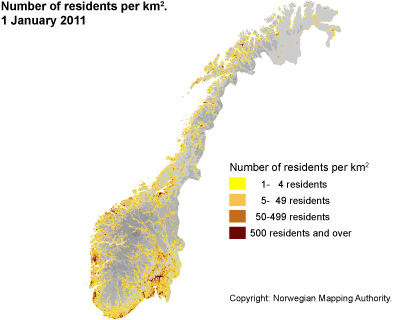Content
Published:
This is an archived release.
More men than women for first time
In the population, which now counts 4 920 300, more men than women have been registered for the first time, with a margin of 1 400. The oldest figures broken down by sex are from the population census in 1769. The change from female to male surplus is a result of different demographic conditions over the last hundred years, but migration to and from abroad in the last five years has been most important.
The change from a surplus of women in excess of 36 000 five years ago to a surplus of males of 1 400 at the turn of the year, is a result of different demographic conditions. The fact that 4-6 per cent more boys than girls are born every year contributes to reducing the female surplus. Furthermore, we have had the particular situation since 1997 that more women than men have died, which is connected with the fact that there are more females than males at the ages where people mostly die. This is due to the strong falling birth figures in the first 15 years after 1920, and because these women live about 6-7 years longer than men. Nevertheless, the absolute most important reason for the change to male surplus is the migration to and from abroad, which since 2005 has contributed to the male surplus in the population by about 20 000.
In a historical perspective, the female surplus has varied considerably; between 1 100 females per 1 000 males in 1769 and 1 007 in 1960, but women have always been in the majority. After the mid-1960s, the figure increased to 1 022 females per 1 000 males around 1990, and then decreased again. Measured in persons, the surplus of women was highest in 1910, with more than 87 000, while in 1960 it was above 12 000.
Polish citizens are the largest group
The number of foreign citizens grew by 35 400 to 369 300 from 2010 to 1 January 2011, and accounted for 7.5 per cent of the total population at the end of the year. Only in the year 2008 has the growth of foreign citizens been higher, with 36 700. The number of Polish citizens grew the most in 2010, as has been the case every year since2004. A total of 55 200 Polish citizens lived in Norway on 1 January; 8 500 more than the year before. Swedish citizens followed as the next largest group, with 39 200 residents, followed by Germans with 22 400 residents, Danish with 20 900 and Lithuanians with 16 400.
The highest growth in the number of foreigners after the Poles was the Lithuanian and Swedish citizens, with 6 000 and 3 400 respectively.
Many Polish men and Swedish women
Of the foreign citizens, 53 per cent were men. The corresponding figure in 2006 was 49 per cent. This change is due to the many male Polish citizens aged 30-39 years who have come here to work. Men in this age group accounted for 25 per cent of all Polish citizens resident in Norway.
While Polish men made up the largest group of male foreigners, Swedish women formed the largest group among women. In the age group 20-29 years there were a few more women than men among Swedish citizens, while the men were in the majority among Swedish citizens aged 30-66 years.
Seen in relation to the population, there were most foreign citizens in the municipalities Træna, Hemsedal, Oslo and Fjaler, with respectively 15.5, 15.0, 13.5 and 13 per cent. There were fewest in Bindal, Åfjord, Beiarn and Rindal, where they represented less than 1.5 per cent of the population.
It is particularly immigration and emigration, but also the transition to Norwegian citizenship that leads to changes in the number of residents with foreign citizenship.
Residents on map99.8 per cent of the population can now be placed on a map. This makes it possible to illustrate the population structure using grids. |
Tables:
- Table 1 Population, by age and county. Absolute figures. 1 January 2011
- Table 2 Population, by age and county. 1 January 2011. Per cent
- Table 3 østfold
- Table 4 Akershus
- Table 5 Oslo
- Table 6 Hedmark
- Table 7 Oppland
- Table 8 Buskerud
- Table 9 Vestfold
- Table 10 Telemark
- Table 11 Aust-Agder
- Table 12 Vest-Agder
- Table 13 Rogaland
- Table 14 Hordaland
- Table 15 Sogn og Fjordane
- Table 16 Møre og Romsdal
- Table 17 Sør-Trøndelag
- Table 18 Nord-Trøndelag
- Table 19 Nordland
- Table 20 Troms Romsa
- Table 21 Finnmark Finnmárku
- Table 22 Population, by sex and age. Oslo. Urban district. 1 January 2011
- Table 23 Population, by age. Oslo. Urban district. 1 January 2011. Per cent
- Table 24 Population, by sex and age. Bergen. Urban district. 1 January 2011
- Table 25 Population, by age. Bergen. Urban district. 1 January 2011. Per cent
- Table 26 Population, by sex and age. Stavanger. Urban district. 1 January 2011
- Table 27 Population, by age. Stavanger. Urban district. 1 January 2011. Per cent
- Table 28 Population, by sex and age. Trondheim. Urban district. 1 January 2011
- Table 29 Population, by age. Trondheim. Urban district. 1 January 2011. Per cent
- Table 30 Population, by marital status, sex and age. 1 January 2011
- Table 31 Foreign citizens. Number and as a percentage of population, by county. 1 January 1976-2011
- Table 32 Foreign citizens, by citizenship, sex and age. 1 January 2011
- Table 33 Foreign citizens, by citizenship per 1 January 1975-2011
- Table 34 Population by sex, age and marital status. 1 January 2011
Contact
-
Magnus Haug
E-mail: magnus.haug@ssb.no
tel.: (+47) 40 81 14 91
-
Karstein Sørlien
E-mail: karstein.sorlien@ssb.no
tel.: (+47) 47 70 16 35
-
Linn Krokedal
E-mail: linn.krokedal@ssb.no
tel.: (+47) 95 47 97 47
-
Anders Sønstebø
E-mail: anders.sonstebo@ssb.no
tel.: (+47) 46 66 37 74
-
Espen Andersen
E-mail: espen.andersen@ssb.no
tel.: (+47) 92 61 00 46
-
Statistics Norway's Information Centre
E-mail: informasjon@ssb.no
tel.: (+47) 21 09 46 42
-
Oppdrag befolkningsstatistikk
E-mail: befolkning@ssb.no

